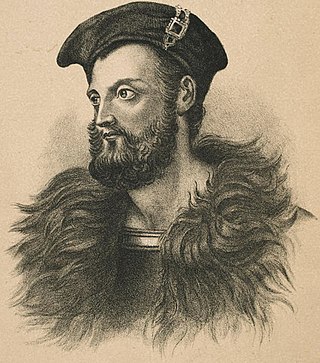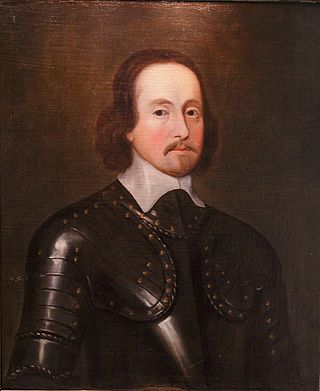
Lieutenant-General James FitzThomas Butler, 1st Duke of Ormond, KG, PC, was an Anglo-Irish statesman and soldier, known as Earl of Ormond from 1634 to 1642 and Marquess of Ormond from 1642 to 1661. Following the failure of the senior line of the Butler family, he was the second representative of the Kilcash branch to inherit the earldom.

Owen Roe O'Neill was a Gaelic Irish soldier and one of the most famous of the O'Neill dynasty of Ulster. O'Neill left Ireland at a young age and spent most of his life as a mercenary in the Spanish Army serving against the Dutch in Flanders during the Eighty Years' War. After the Irish Rebellion of 1641, O'Neill returned and took command of the Irish Confederate Ulster Army. He is known for his victory at the Battle of Benburb in 1646.

The Irish Confederate Wars, also called the Eleven Years' War, took place in Ireland between 1641 and 1653. It was the Irish theatre of the Wars of the Three Kingdoms, a series of civil wars in the kingdoms of Ireland, England and Scotland – all ruled by Charles I. The conflict had political, religious and ethnic aspects and was fought over governance, land ownership, religious freedom and religious discrimination. The main issues were whether Irish Catholics or British Protestants held most political power and owned most of the land, and whether Ireland would be a self-governing kingdom under Charles I or subordinate to the parliament in England. It was the most destructive conflict in Irish history and caused 200,000–600,000 deaths from fighting as well as war-related famine and disease.

Sir Phelim Roe O'Neill of Kinard was an Irish politician and soldier who started the Irish rebellion in Ulster on 23 October 1641. He joined the Irish Catholic Confederation in 1642 and fought in the Wars of the Three Kingdoms under his cousin, Owen Roe O'Neill, in the Confederate Ulster Army. After the Cromwellian conquest of Ireland O’Neill went into hiding but was captured, tried and executed in 1653.

The Irish Rebellion of 1641 was an uprising in Ireland, initiated on 23 October 1641 by Catholic gentry and military officers. Their demands included an end to anti-Catholic discrimination, greater Irish self-governance, and return of confiscated Catholic lands. Planned as a swift coup d'état to gain control of the Protestant-dominated central government, instead it led to the 1641–1653 Irish Confederate Wars, part of the wider Wars of the Three Kingdoms.

Confederate Ireland, also referred to as the Irish Catholic Confederation, was a period of Irish Catholic self-government between 1642 and 1652, during the Eleven Years' War. Formed by Catholic aristocrats, landed gentry, clergy and military leaders after the Irish Rebellion of 1641, the Confederates controlled up to two-thirds of Ireland from their base in Kilkenny; hence it is sometimes called the Confederation of Kilkenny.

The Cromwellian conquest of Ireland (1649–1653) was the re-conquest of Ireland by the Commonwealth of England, initially led by Oliver Cromwell. It forms part of the 1641 to 1652 Irish Confederate Wars, and wider 1639 to 1653 Wars of the Three Kingdoms. Modern estimates suggest that during this period, Ireland experienced a demographic loss totalling around 15 to 20% of the pre-1641 population, due to fighting, famine and bubonic plague.

The siege of Drogheda took place from 3 to 11 September 1649, at the outset of the Cromwellian conquest of Ireland. The coastal town of Drogheda was held by a mixed garrison of Irish Catholics and Royalists under the command of Sir Arthur Aston, when it was besieged by English Commonwealth forces under Oliver Cromwell. After Aston rejected an invitation to surrender, the town was stormed and much of the garrison executed, along with an unknown but "significant number" of civilians. The aftermath of the siege is viewed as an atrocity which still impacts Cromwell's modern reputation.

The Battle of Scarrifholis, also spelt Scariffhollis was fought on 21 June 1650, near Letterkenny in County Donegal during the Cromwellian conquest of Ireland. A force loyal to the Commonwealth of England under Charles Coote defeated the Catholic Ulster Army, commanded by Heber MacMahon, Roman Catholic Bishop of Clogher.

Michael Jones was an Irish-born Protestant soldier of Welsh descent who fought in the War of the Three Kingdoms, primarily in Ireland. Third son of Lewis Jones, Bishop of Killaloe, his brothers Henry and Ambrose were also bishops in the Church of Ireland.

The Sack of Wexford took place from 2 to 11 October 1649, during the Cromwellian conquest of Ireland, part of the 1641–1653 Irish Confederate Wars. English Commonwealth forces under Oliver Cromwell stormed the town after negotiations broke down, killing most of the Irish Confederate and Royalist garrison. Many civilians also died, either during the sack, or drowned attempting to escape across the River Slaney.
The Battle of Arklow was a minor skirmish that took place at Glascarrig on the coast road near Arklow in County Wicklow on 1 November 1649. It was fought between the army of the Parliamentarians and the combined forces of the Irish Royalists and Confederates during the Irish Confederate Wars.

The Battle of Lisnagarvey was fought on 6 December 1649, near Lisnagarvey during the Irish Confederate Wars, an associated conflict of the 1638 to 1651 Wars of the Three Kingdoms. Forces loyal to the Commonwealth of England defeated an army supporting Charles II of England, composed of Royalists and Scots Covenanters.

Charles Coote, 1st Earl of Mountrath was an Anglo-Irish soldier and politician from County Roscommon. A strong advocate of the Protestant Ascendancy in Ireland, he fought for Parliament and the Commonwealth in the 1641 to 1652 Irish Confederate Wars. Coote also sat as an MP, and held various senior administrative posts, including Lord President of Connaught.
Presented below is a chronology of the major events of the Irish Confederate Wars from 1641 to 1653. This conflict is also known as the Eleven Years War. The conflict began with the Irish Rebellion of 1641 and ended with the Cromwellian conquest of Ireland (1649–53).

Robert Venables was an English soldier from Cheshire, who fought for Parliament in the 1638 to 1651 Wars of the Three Kingdoms, and later served under the Commonwealth of England.

Sir Theophilus Jones, was an Irish soldier and government official of Welsh descent. One of five sons born to Lewis Jones, Bishop of Killaloe in the Church of Ireland, he formed part of a close-knit and powerful Protestant family.
The siege of Dublin took place in 1649 during the Irish Confederate Wars. It was a failed attempt by combined Irish Royalist and Confederate forces to capture the capital of Dublin which was held by English Republican forces under Michael Jones. It was part of a strategy by Duke of Ormonde, head of an alliance loyal to Charles II, to seize the remaining foothold of Ireland still under the control of the London Parliament.
Lieutenant-General Patrick Purcell of Croagh was an Irish soldier. In his youth he fought in Germany during the Thirty Years' War. Back in Ireland he joined the Irish Rebellion of 1641 in 1642 when it reached Munster. He commanded units of the Confederate Munster Army, or precursors and successors of it, from 1642 to 1651 under their successive commanders-in-chief, Viscount Mountgarret, General Garret Barry, Viscount Muskerry, the Earl of Castlehaven, the Marquess of Ormond, and finally Hugh Dubh O'Neill. In 1651 at the surrender of Limerick to the Parliamentarians, he was excepted from pardon and executed by Henry Ireton.

The Second Ormonde Peace was a peace treaty and alliance signed on 17 January 1649 between the Marquess of Ormonde, the leader of the Irish Royalists, and the Irish Confederates. It united a coalition of former Protestants and Catholics enemies from Ireland, Scotland and England – the three Kingdoms ruled by Charles I who was then held a prisoner by the Puritan Rump Parliament. His execution on 30 January drew together the signatories in allegiance to his young son Charles II.


















